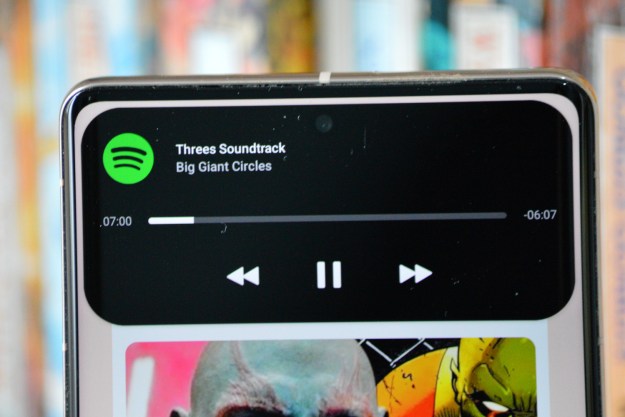At any given moment, there are approximately a zillion crowdfunding campaigns on the web. Take a stroll through Kickstarter or Indiegogo, and you’ll find no shortage of weird, useless, and downright stupid projects out there — alongside some real gems. In this column, we cut through all the worthless wearables and Oculus Rift ripoffs to round up the week’s most unusual, ambitious, and exciting projects. But don’t grab your wallet just yet. Keep in mind that any crowdfunded project can fail — even the most well-intentioned. Do your homework before cutting a check for the gadget of your dreams.
Rumpl Puffe — Heated outdoor blanket
There’s nothing quite as glorious as crawling into a warm bed that’s been preheated by an electric blanket on a cold winter night. Thing is, unless you have a ridiculously long extension cord, you can’t really take an electric blanket with you anywhere outside of your bedroom — which sucks, because a super warm blanket would be particularly useful on camping trips, tailgate parties, and other outdoor excursions. Thankfully, there’s a clever new product on Kickstarter that aims to change all that.
The Rumpl Puffe, as it’s called, is essentially an electric blanket built for use in the outdoors. An integrated Ravean carbon heating system, powered by a rechargeable USB battery pack, gives this blanket a level of warmth that is unmatched by any other camping quilt. It’s still lightweight and highly packable, and a durable water-repellent (DWR) finish helps keep it dry. Available with two different types of insulation — natural, sustainably sourced down, or synthetic fill — the Puffe is naturally warm all on its own if the battery dies, too.
Foldscope — Ultra-cheap origami microscope
For all those moments when you wish you could examine an object in excruciating detail (because we know those moments come often), it’s always a shame that you can’t just whip a microscope out of your pocket. But lament no longer, friends. With Foldscope, you can finally have a microscope that fits in your wallet. The very niche (but very cool) device is credit card-sized and connects wirelessly to your smartphone, allowing you to “discover the microcosm in all its facets, wherever you are.”
In addition to the clever origami-inspired design, it’s also outrageously cheap. The entire apparatus is made from a simple list of parts: a sheet of plastic-coated paper (6 cents), a ball lens (17 cents for low magnification, 56 cents for high magnification), a 3-volt battery (6 cents), an LED light (21 cents), a switch (5 cents) and some copper tape (3 cents). Don’t pull out your calculator – that’s 58 cents for the low-magnification version of the Foldscope and 97 cents for the high-magnification version. Hooray for democratizing scientific instruments!
PocketLab Voyager — Sensor pack for citizen science
Scientific experimentation is easy if you’ve got access to the right tools, but for those of us without keys to a lab full of equipment, collecting and analyzing data from the physical world is often a daunting task. Stanford grad student Clifton Roozeboom (for real) aims to change that, and put cheap, easy-to-use research tools in the hands of anyone who wants them.
To do this, he has developed a small multisensor called PocketLab Voyager. This durable little box is outfitted with all the necessary sensor tech to measure acceleration, force, angular velocity, magnetic fields, pressure, altitude, and temperature. Using the accompanying cloud software, you can easily analyze all the data you collect, create graphs, and integrate your data with other software. It’s everything you need to get out there and start gathering information about the world around you.
FlowMotion One — Handheld/wearable smartphone gimbal
FlowMotion is on a mission to rid the world of shaky handheld video footage. How? By making stabilizer technology more accessible than ever before. The company recently headed to Kickstarter to launch the FlowMotion One: a three-in-one, mountable, wearable smartphone gimbal. That’s right — wearable. Unlike other handheld gimbals, you don’t necessarily have to hold this sucker in your hand.
To make this possible, FlowMotion had to do some pretty fancy footwork with the design. Most gimbals keep their battery in the handle, but by moving the One’s three-hour battery behind the smartphone, FlowMotion figured out a way to ditch the handle altogether, thereby allowing the gimbal to be worn or mounted while taking up minimal space — about five inches above the mount. It’s certainly not the first
NūFood — 3D food printer
3D printers can pump out a wide variety of different foods these days — everything from candy and chocolates to pizza and pancakes. Thing is, most food printers are designed to print a specific type of food, and can therefore only produce a small range of flavors. NuFood, however, isn’t limited to one type of food or one subset of flavors. Instead, the printer uses a molecular gastronomy technique called spherification to produce gelatinous capsules that can be flavored like pretty much anything.
Here’s how it works. The machine starts by squirting out a flavored liquid in the same way a normal printer would extrude plastic filament. But rather than pumping it onto a solid baseplate, the juice drips into a cold bath of liquid calcium chloride. This causes the juice –which has been mixed with alginic acid– to start a chemical reaction that produces an edible skin around the ball of liquid. The resulting globules resemble that of caviar or tapioca pearls, but taste like whatever flavor material they’re made with.
Editors' Recommendations
- Let’s be honest, you probably can’t hear lossless audio
- Google is going to change Pixel phones forever, and I can’t wait
- Here’s why you can’t sign up for ChatGPT Plus right now
- Security or performance? With this AMD vulnerability, you can’t have both
- AMD’s new laptop CPU is the fastest I’ve seen, but you shouldn’t buy it yet




